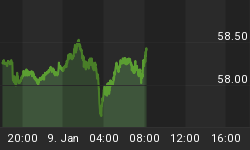The best way to protect your wealth from the ravages of inflation is to invest in a tangible asset whose supply cannot be increased at the same rate as the currency it is being measured in. Even better is to invest in an asset with growing demand and limited supply whose intrinsic value is increasing.
Some traditional inflation protection vehicles include precious metals, crude oil, real estate and Treasury Inflation Protection Securities (TIPS). A quick comparison shows that oil, for example, has been an excellent hedge against inflation a 37-year compounded return of 8.5%. Real estate, meanwhile, has returned 6.15% over that same span since 1970.
Even worse inflation protection are TIPS, which have provided and average compounded yield of just 5.4% since their inception in 1997. By comparison, gold's return over that same ten-year timeframe has been 8.7%-- no contest.
Despite the multi-year rally we've seen across most of the commodity spectrum, only recently have investors looked to agricultural commodities as another inflation hedge. Due to several watershed macroeconomic factors, this asset class may be entering into a secular trend which will cause it to be a leading provider of real returns. Some of the macroeconomic trends are:
-
World population to reach 7 Billion by 2013 source: United Nations information service
-
Global GDP to remain above trend through 2016/17 leading to improving dietary trends source: FAPRI
-
Global grain demand to increase 40% by 2020 source: World Resource Institute
-
By the year 2009/2010 fuel is expected to consume 30% of maize crop source: FAPRI
The Agriculture Story
Global money supply is growing at approximately 15%, far above the production rates of most commodities. Like gold, the increase in the supply of agricultural commodities is also running far below the rate of global money supply growth. Unlike gold, however, the intrinsic value of agricultural commodities is increasing because of their burgeoning use in energy production, the shrinking of available hectares devoted to crop production and growing demand from an increasingly wealthy world population.
Not only is the supply and demand balance for these commodities favorable today, but estimates from the Food and Agricultural Policy Research Institute (FAPRI) suggest the supply/demand balance will remain tight for the foreseeable future. Evidence of today's tightness is the fact that current stock-to-use ratios for many agricultural commodities are at historic lows.
Higher Prices to Continue
Prices should remain elevated as productivity struggles to keep up with surging demand. According to FAPRI, prices of course grains (corn, sorghum and barley) should remain 50% above their 10 year average until at least 2016/17. And over the next 10 years sugar and wheat should be 26% and 39% higher, respectively, than their averages.
In conducting our research while consulting on the Delta Global Agriculture UIT, we were convinced that investors interested in gaining agriculture exposure through equities should focus on agriculture producing companies (i.e. growers) or those who are closely related to them, such as seed and agricultural chemicals companies. Amazingly, there are those who consider a company such as Kellogg's to be an agricultural stock; in our opinion, it isn't. In fact, such packaged foods producers likely stand to be harmed by the trend of rising agricultural commodities prices, as a few high-profile earnings warnings have recently highlighted.
Finally, it should be noted that agricultural commodities have not historically been an effective inflation hedge, as they are still 60-90% below their inflation-adjusted highs in some cases. However, due to the above-mentioned macroeconomic changes that are in still in their infancy, I believe we may be in the early stages of a long-term secular trend in which these commodities will far outpace the rate of inflation.
Although this sector is starting to get noticed, we think it is still a little-known story. In the very near future, however, owning agricultural commodities may be broadly viewed as an excellent hedge against inflation and a necessary component of a well diversified portfolio.
















